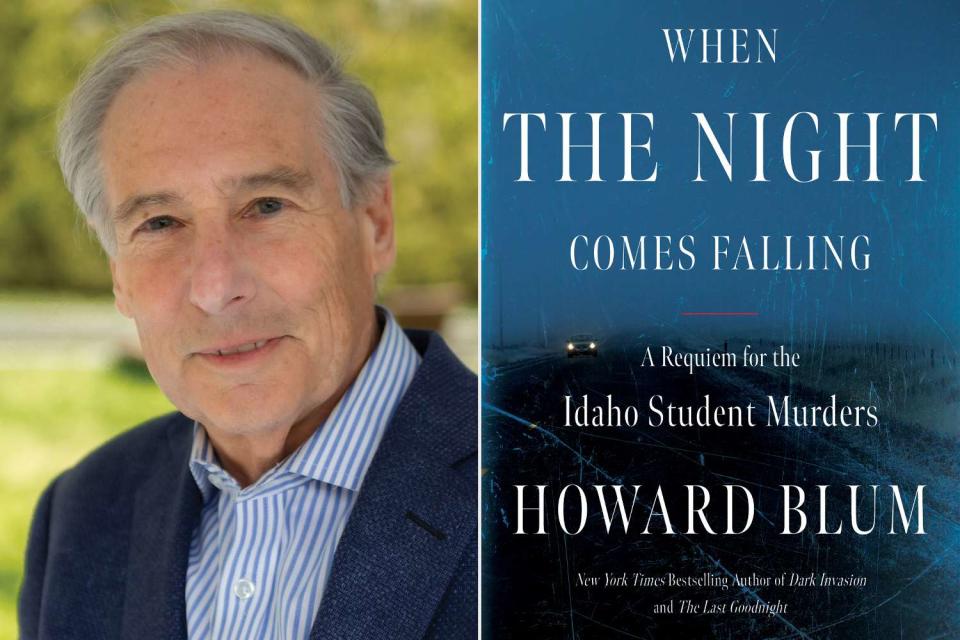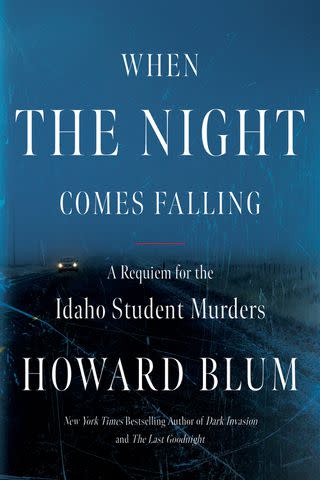Author Howard Blum Opens Up About Chronicling Idaho Murders in New Book 'When the Night Comes Calling' (Exclusive)
- Oops!Something went wrong.Please try again later.
"A crime that is the worst nightmare of every parent who sends their children off to college," Blum exclusively tells PEOPLE

Anthony Lattari; Harper
Howard Blum and "When the Night Comes Falling" coverHoward Blum is opening up about his latest book which chronicles the University of Idaho murders case.
The Pulitzer Prize-nominated author spoke exclusively with PEOPLE about the process of writing When the Night Comes Calling: A Requiem for the Idaho Student Murders, including his time spent interviewing people in Moscow, Idaho, before murder suspect Bryan Kohberger had been arrested — and what surprised him most about the 2022 gruesome quadruple murder case.
Throughout the 240-page book, he details an in-depth account of the police manhunt that eventually led to the arrest of Kohberger.

Anthony Lattari
Howard BlumNever miss a story — sign up for PEOPLE's free daily newsletter to stay up-to-date on the best of what PEOPLE has to offer, from celebrity news to compelling human interest stories.
On Nov. 13, 2022, four University of Idaho students, Madison Mogen, 21, Kaylee Goncalves, 21, Xana Kernodle, 20, and Ethan Chapin, 20, were all stabbed to death in bedrooms on the second and third floor of a home in Moscow, Idaho. More than a month after the murders took place, Kohberger, 29, was arrested in Pennsylvania — the same day a memorial was scheduled for Mogen and Goncalves.
In May 2023, Kohberger was indicted by a grand jury for the murder of the four students. Kohberger has since pleaded not guilty, waived his right to a speedy trial and recently appeared in court for two hearings on Jan. 26, 2024. As of April 2024, no new trial date has yet to be set by Judge John Judge — the prosecution requested a summer of 2024 trial and the defense asked for a March or summer of 2025.
Blum, also author of Wanted!, The Last Goodnight and In the Enemy’s House, tells PEOPLE how investigating this case was “exhaustive and exhausting,” but he tried to “find something uplifting in the tragedy.” He explains that he chose to memorialize the four young students whose lives “were lost all too soon.”
Since releasing When the Night Comes Falling: A Requiem for the Idaho Student Murders in late June, the book has become an instant NY Times bestseller and is being developed into a scripted series.
Below are more of Blum’s revelations about the case that gripped the nation.
When did you decide to write this book?
We were sitting around the Thanksgiving table nearly two years ago when the talk turned to the perplexing murders of four college students that had occurred not much more than a week earlier in Moscow, Idaho. This was not as strange as it might seem; the grim events had been all over the news, and by this point in the long-running meal we had exhausted the old standbys of politics and family dramas.
As I listened to the conversation, I grew increasingly fascinated; previously I had not paid too much attention to the barrage of daily news stories detailing the tragedy. But now I realized that there was so much that remained unknown – four young deaths, and no sign of a motive or, for that matter, any clues that might lead to a suspect. It was a real-life mystery and it was just beginning to unfold. And over the long holiday weekend that followed, I, someone who has measured out his professional life as a journalist and an author chasing down intriguing, puzzling stories, decided that I wanted to head off to Moscow, Idaho, and see what I could discover. Within days, I was flying into a blustery Moscow (Idaho)-Pullman(Washington) airport and starting to knock on doors.
How did you begin to gather information?
In the early days of the case, when I first arrived in Idaho, it was relatively easy to get people to talk. In those days before a suspect had been apprehended, there was no judicial gag order that prohibited the police investigators from talking about the case. Therefore, I was able to get into conversations with sources who had first-hand knowledge of the investigation. Later, these sources would be more reluctant. However, I had also established relationships with people on the periphery of the case who nevertheless worked with the authorities, individuals such as auxiliary officers and department psychologists. They proved very helpful.
And later, once the suspect had been arrested, I used a technique inspired by the Investigative Genetic Genealogy the FBI had employed to build their case. The bureau used DNA to build a family tree whose branches ultimately reached out to the suspect, Bryan Kohberger, a criminology graduate student at Washington State University. I, very broadly, retraced the bureau’s steps in reverse. That is, I reached out to relatives of the suspect’s family and in the process, I got genuine insight into the family dynamics that centered around a troubled man who found himself in the crosshairs of a quadruple murder investigation.
Related: Idaho Murder Suspect: What We Know About Bryan Kohberger

Harper
"When The Night Comes Falling" coverDid writing a book about such gruesome crime take a toll on you?
It was an exhaustive and exhausting process. But I also tried to find something uplifting in the tragedy I was writing about. The book is subtitled “A Requiem for the Idaho Student Murders,” and I very much wanted my book to be not just a suspenseful unfurling of a police manhunt for a killer, but also I wanted it to be a fitting memorial to the four young lives that were lost all too soon. I had learned while researching this book, for example, that Xana Kernodle, one of the victims, wore a mortarboard to her high school graduation inscribed with the words, “For the lives I will change.” The sad fact that Xana and Maddie, Kaylee, and Ethan will never get the opportunities they should rightly have had to affect other lives [and] accomplish their dreams stayed with me throughout the course of writing this book.
What surprised you most?
Two things: The antagonism between the Moscow police taskforce and the FBI agents assigned to this case. As I reveal, this nearly threw the entire investigation into disarray.
And the other is my belief that, as I reconstruct in detail the events that happened on the night of the murders, the killer entered the students’ house with just only one target in mind – Maddie Mogen. All the other deaths were unplanned, simply and horrifically, collateral damage – the rage of a monster trying to escape from his crime.
Related: The Idaho Student Murders Shocked the Nation — Now a New Book Explores What Happened (Exclusive)
Why do you think this case captivated the world?
For one thing, it was the victims. Their youth, their beauty, their exuberance – it was all so striking. And it made it into a crime that was also the worst nightmare of every parent who sends their children off to college.
And for another, it was the perplexing mystery surrounding the events. A crime with no motive, no found murder weapon, no forced entry, no trail of blood leaving the scene of the crime – and for six long weeks no suspect. It was an opportunity for legions of armchair detectives to go onto the internet and play sleuth, to see if they could identify the pieces that would when assembled, make sense of all that had happened.
What was the biggest challenge for you when writing?
I needed to find a way to tell this complex story that would not only allow me to break some news, but would also allow me to shape a page-turning narrative. And it took me a while before I decided to structure my book around the cross-country trip the suspect takes with his father just weeks after the murders as they return from Washington State to Pennsylvania for the Christmas holidays. It was a road trip from hell, a father slowly coming to the realization, I believe, that his son might very well be a monster – and yet he is unable to confront his fears. It is a trip filled with moments of high drama, and it allowed me to enter the story at a point that would heighten both the suspense, the character development, and the narrative tension of the entire tale I was determined to tell.
For more People news, make sure to sign up for our newsletter!
Read the original article on People.

